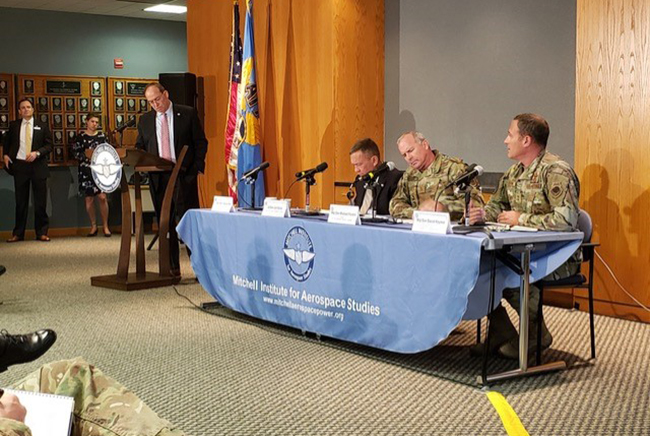
Experts discussed next-generation air superiority at an Aug. 7 AFA Mitchell Institute for Aerospace Studies event in Arlington, Va. AFA courtesy photo.
The Air Force needs to convince Congress about the merit of its Next-Generation Air Dominance program, a “system of systems” aimed at ensuring air superiority into the 2040s, the service’s top planners said Aug. 7.
The service is planning to integrate current and future systems into a multi-domain network that takes over the role now played by its highest-end stealth fighters, instead of following fifth-generation aircraft with a single sixth-generation platform.
Congress, however, needs some convincing to support the effort. House lawmakers propose slashing fiscal 2020 funding for NGAD from $1 billion to $500 million due to “cost risk associated with development,” according to the House-passed version of the 2020 defense policy bill.
Maj. Gen. David Krumm, director of Air Force global power programs, wants to make clear what NGAD is not: a singular item, a platform, or a substitute for earlier systems.
“It is a network-connected family of systems that gets after things we need for our nation to ensure air superiority,” Krumm said during an Aug. 7 AFA Mitchell Institute for Aerospace Studies event in Arlington, Va. “It is a multitude of things. What we are pursuing is a multiple number of [air, land, sea, cyber, and space] technologies and capabilities.”
The Air Force doesn’t want to limit itself by simply designing a new, exquisite airplane, because ensuring current and future systems can work together will be more important to ensure control of the air, Krumm said.
“The other thing we know is that NGAD will be constantly evolving,” he said.
But Congress remains unconvinced. Krumm said there’s more work to do to sell lawmakers on the idea that focusing on the network—as the Air Force is doing with the Advanced Battle Management System and multi-domain command and control—is vitally important. He likened it to Twitter’s ability to spread information among millions of people who can find and verify it in real-time.
Krumm acknowledged that “scar tissue” remains from bringing previous system-of-systems ideas to Capitol Hill.
“We know the future and we’ve got to do a really good job of articulating it to Congress,” he said.
Maj. Gen. Michael Fantini, director of the Air Force Warfighting Integration Capability, noted his planning group is standing up cross-functional teams that can illustrate how disparate concepts might work together. He’s the one in charge of charting out where individual programs connect to enterprise visions, and “we need to show progress toward that,” he said.
Air Force acquisition chief Will Roper’s “Century Series” idea, aimed at digitally evaluating platforms that could be rapidly designed and fielded with a short production run and a short service life, is one approach that could allow the service to rapidly fill capability gaps for air superiority, Krumm said.
The service needs to cycle quickly through technology design to operations in just a few years, Krumm continued, putting prototypes in service that can then be refined for a particular mission and retired when they’re no longer useful.
If congressional funding cuts are made permanent in the 2020 budget, it would limit the Century Series, potentially delaying prototyping efforts by years, a senior Air Force official told Air Force Magazine. The idea won’t produce more than 100 aircraft per design, in order to keep the concept lean and bolster competition among defense contractors, the official said.
If the Air Force buys more than 100 copies of any particular aircraft under the Century Series, “we will have failed,” the official said.
